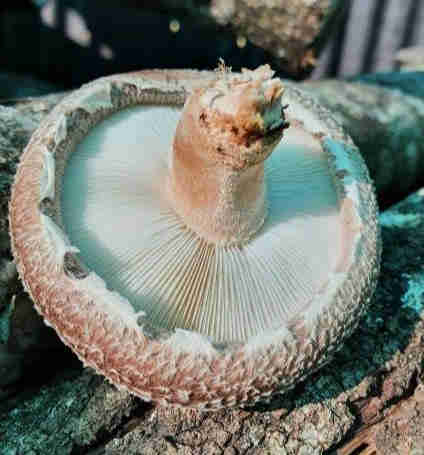Uncategorized
spore print mushroom
Benefits of Mycelial Mulch
A major function of decomposer fungi like Garden Giant or Oysters is cycling organic matter back into the soil. Through decomposition, they break down complex organic molecules into simpler forms, easier to access by plants spore print mushroom . This process helps create long term storage of nutrients. More organic matter also means better water holding capacity, porosity (important for clay-heavy soils) spore print mushroom , and soil structure or tilth. That’s a lot!
Mulching within your garden can also help with weed control. Less weed pressure means less of a need for tilling, thereby leaving the microbial soil communities intact, including mycorrhizal fungi that partner with plants. The microbiome of the soil is crucial for plant health. Research from the Rodale Institute has linked healthy soils to healthy people. It makes sense – a robust microbiome in the soil, dense with nutrients, fortifies the fruits and vegetables we eat. spore print mushroom. spore print mushroom
Wine Caps and Oysters may also act as biocontrol agents in your garden for certain pests, helping to mitigate root rot. They have the innate ability to trap, penetrate, and absorb nutrients like nitrogen and phosphorus from nematodes.
The 4-stage life-cycle of the shiitake fruiting block

A shiitake block that has just colonised
❖ Stage 1 “Colonising”- You have mixed your shiitake spawn with sterile substrate, now the block is colonising and held together by white mycelium. The block is made up of sterilised sawdust and bran inside a special filter-patch-bag which allows air exchange while keeping a sterile environment inside the bag. Leave the block in the plastic bag until stage 3 is complete.spore print mushroom. spore print mushroom

Shiitake block in the “Popcorning” stage
❖ Stage 2 “Popcorning”– The block begins to ‘popcorn’ forming bulbous knots, bumps and blisters all over it. Once the ‘popcorning’ process starts, avoid handling the block as much as possible. The block is now essentially shock-sensitive, as, in nature, shiitake mushrooms will commonly fruit after the tree that they are growing on falls and impacts the ground. Touching, moving, or handling the block during this stage can induce premature fruiting, which will reduce mushroom yield. If the block does begin to produce mushrooms under the plastic the bag will need to be removed and move to “Stage 4 – Fruiting/ Mushroom Production Time”. spore print mushroom north spore mushroom

Shiitake log browning ready for pinning
❖ Stage 3 “Browning”- The surface of the block will begin to go dark brown, many first time shiitake growers think that this is contamination, but it is ideal … this is what you want to see! It is ready to fruit once the block is at least 50-70% brown. The block is now ready to be handled and produce mushrooms! This is when you remove it from the plastic bag. spore print mushroom

Shiitake block pinning baby mushrooms
❖ Stage 4 “Pinning and Fruiting”- Fruiting/ Mushroom Production! Remove the plastic bag by cutting with a clean razor, it is not a problem if you cut the block a little. Spray water directly on the block until dripping wet morning and night for 2-3 days until you start seeing little mushrooms appear. You can stop spraying when the mushrooms begin appearing on the block. spore print mushroom
MUSHROOM SPORE PRINTS FOR IDENTIFICATION
The color of a mushroom spore print can be a key identification factor for many species. mushroom spore laws in texas
That being said, some discretion definitely needs to be used and spore color alone should never be used to identify a species for consumption.spore print mushroom
Identification guides will often be quite vague in the description of spore color.
Sometimes it will be quite obvious, like white or purple- but how are you supposed to tell the difference between rusty-brown and orange-brown? White and cream?
Everybody sees and interprets colors a little differently, so be sure to have alternate ways of identifying species. Also, if you are taking a spore from a species and you have no idea what to expect, consider grabbing a few fruits and making multiple spore prints on different colors of paper.
Here are some examples of different mushrooms and their spore colors:
- Oyster Mushrooms – Typically White
- Button Mushrooms (Agaricus species) – Usually Brown
- Reishi – Brown
- Shaggy Mane (Coprinus) – Black
- Amanita Species (Death Cap, Fly Agaric) – Usually White
- Enoki (Flamulina Velutipes) – White
- Psilocybe Species – Dark Purple/Black
Other than color, most spore characteristics are not visible to the naked eye and need to be identified by looking at the spores under a microscope. This is usually done by making the spore print on a microscope slide. Spores can all sorts of shapes- oval, square, circular- as well as being vastly different sizes spore print mushroom . spore print mushroom
Since most people don’t have a spare microscope laying around, it’s generally not a great characteristic for casual identification.
Finding a good spot for your shiitake block!
As stated above, once the block starts to popcorn, it shouldn’t be disturbed until it is ready to fruit. Finding a spot where the kids or family pets won’t knock it over during this stage is essential. Bathroom and high kitchen benches are usually ideal, but anywhere out of direct sunlight will do. If you have a busy household, potentially above the fridge will be a perfect spot! (Just remember to put an alarm in your calendar to check on it after 40-50 days). The blocks are normally ready to fruit 50-70 days from the date on the bag.

harvest-ready shiitake mushroom fruiting block in the garden
How many times will the block fruit?
In a perfect environment, the block will fruit up to 5 times before using up all of its available nutrients. However, in a non-sterile setting such as the house, it may fruit only a few times before getting contaminated with foreign moulds (usually green-mould, like on your bread). At this point you can put it out in your garden, out of direct sunlight, to continue fruiting. Once the block is used up and no longer producing mushrooms, you can put the entire block in the compost or disperse it anywhere in the garden.

Gills showing on the shiitake mushroom
Harvesting – Shiitake mushrooms are ready to harvest as soon as you can see the gills underneath. Harvest by cutting the stem off as close to block as possible. Fresh shiitakes will last in the fridge for up to two weeks. spore print mushroom
Successive fruiting – Once you have harvested all the mushrooms off the block initially, leave the block to rest and dry for 2 weeks. To induce the second fruiting, submerge the block completely under cold water for 6-12 hours. Remove the block very carefully from the water and sit to allow it to drain. Block will be soft, heavy and fragile until the water drains back out of it. Once it has drained enough, put back it in your chosen spot for growing.
Why grow mushrooms in your garden?
Mushrooms can do so much for your garden! They can inhabit spaces that might otherwise be overlooked or underused. Perhaps you’ve got a shady corner where your vegetables won’t grow, or you’re interested in getting the most out of your garden space. Maybe you don’t have a green thumb at all but still want to grow some delicious food for yourself, your community, or just for fun. By working with fungi, not only are we adding nutrient-dense food to our gardens, but we’re also supporting nutrient cycling and increasing soil health, giving our plants an extra boost to grow.
This summer, we took four common methods of growing mushrooms and adapted them for use in our research garden:
-making mushroom beds
-growing on logs
-growing on straw bales
-growing in containers
These methods are some of the easiest, most reliable ways to grow mushrooms outside. Check out our video below to see how simple it is to incorporate mushrooms into your garden! spore print mushroom








